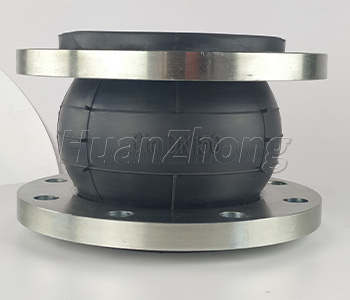Single Ball Rubber Joints Compensate for Displacement and Vibration.
Single Ball Rubber Joints Compensate for Displacement and Vibration. Single ball rubber joints are a type of flexible joint used to compensate for displacement and vibration in various industrial applications. These joints are designed to accommodate axial, lateral, and angular movements, offering a reliable solution for pipeline connections that experience thermal expansion, mechanical stress, or vibration. In this article, we will explore the key features and of single ball rubber joints and their role in compensating for displacement and vibration.
Construction and Design: Single ball rubber joints are typically comprised of a rubber sphere, also known as a bellows, with flanged or threaded end connections. The sphere is made from high-quality rubber that exhibits excellent flexibility, resilience, and resistance to wear and tear. The rubber sphere acts as a flexible element that can absorb movements and vibrations, allowing for smooth operation and preventing damage to the pipeline system.
Compensating for Displacement: One of the main functions of single ball rubber joints is to compensate for displacement or movement in a pipeline system. When a pipeline undergoes thermal expansion or contraction, for example due to temperature changes, it can cause stress and strain on the system. Single ball rubber joints are designed to accommodate this displacement by allowing the rubber sphere to flex and absorb the movement, effectively reducing stress and preventing damage to the pipeline or connected equipment.
Absorbing Vibrations: Vibrations can occur in a pipeline due to various factors such as pumps, compressors, or other machinery. These vibrations can lead to excessive noise, wear, and fatigue, affecting the performance and lifespan of the system. Single ball rubber joints are specially engineered to absorb these vibrations, dampening their effects and ensuring a quieter and more efficient operation. The flexibility of the rubber sphere allows it to absorb and dissipate the energy generated by the vibrations, minimizing their impact on the overall system.
Easy Installation and Maintenance: Single ball rubber joints are designed for easy installation and maintenance. The flanged or threaded end connections simplify the connection process, allowing for quick and secure installation in the pipeline system. Additionally, the flexible nature of the rubber joint makes it easier to handle and position during installation. Maintenance involves periodic inspection for signs of wear or damage, and if necessary, replacement of the rubber joint to ensure continued performance and reliability.
Wide Range of Applications: Single ball rubber joints find applications in various industries, including HVAC systems, water treatment plants, power generation facilities, and chemical processing plants. They are commonly used in piping systems that transport fluids, gases, or slurries, where thermal expansion, mechanical stress, or vibration are prevalent. Single ball rubber joints provide a cost-effective solution for compensating for these movements, reducing the risk of leakage, pipe damage, and equipment failure.

In conclusion, single ball rubber joints are essential components in pipeline systems, offering compensation for displacement and vibration. Their unique design and construction allow for axial, lateral, and angular movement, effectively absorbing these forces and ensuring smooth and reliable operation. With their capacity to accommodate thermal expansion, mechanical stress, and vibration, single ball rubber joints provide a practical and cost-effective solution for maintaining the integrity and longevity of pipeline systems in various industries.

